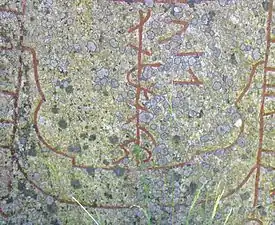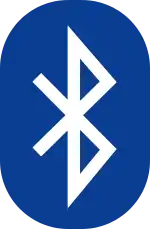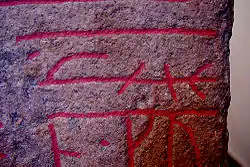Bind rune
A bind rune (Icelandic: bandrún) is a ligature of two or more runes. They are extremely rare in Viking Age inscriptions, but are common in earlier (Proto-Norse) and later (medieval) inscriptions.[1]

On some runestones, bind runes may have been ornamental and used to highlight the name of the carver.[2]
Description
There are two types of bind runes. Normal bind runes are formed of two (or rarely three) adjacent runes which are joined together to form a single conjoined glyph, usually sharing a common vertical stroke (see Hadda example below).[3] Another type of bind rune called a same-stave rune, which is common in Scandinavian runic inscriptions but does not occur at all in Anglo-Saxon runic inscriptions, is formed by several runic letters written sequentially along a long common stemline (see þ=r=u=t=a=ʀ= =þ=i=a=k=n example shown above).[4] In the latter cases the long bind rune stemline may be incorporated into an image on the rune stone, for example as a ship's mast on runestones Sö 158 at Ärsta and Sö 352 in Linga, Södermanland, Sweden, or as the waves under a ship on DR 220 in Sønder Kirkeby, Denmark.[4]
Examples
Elder futhark
Examples found in Elder Futhark inscriptions include:
- Stacked Tiwaz runes: Kylver Stone, Seeland-II-C
- Gebô runes combined with vowels: Kragehul I
- The syllable ing written as a ligature of Isaz and Ingwaz (the so-called "lantern rune").[5]
Anglo-Saxon Futhorc
Bind runes are not common in Anglo-Saxon inscriptions, but double ligatures do sometimes occur, and triple ligatures may rarely occur. The following are examples of bind-runes that have been identified in Anglo-Saxon runic inscriptions:[6][7]


- The word gebiddaþ is written with a ligatured double ᛞ (dd) on the Thornhill III rune-stone
- The name Hadda is written with a ligatured double ᛞ (dd) on the Derbyshire bone plate
- The word broþer is written with a ligatured ᛖ and ᚱ (er) on some Northumbrian stycas
- The Latin word meus is written as mæus with a ligatured ᛗ and ᚫ (mæ) on the Whitby comb
- The inscription [h]ring ic hatt[æ] ("ring I am called") is written with a ligatured ᚻ and ᚪ (ha) on the Wheatley Hill finger-ring
- The names of the evangelists, Mat(t)[h](eus) and Marcus are both written with a ligatured ᛗ and ᚪ (ma) on St Cuthbert's coffin
- The name Dering may be written with a triple ligatured ᛞ, ᛖ and ᚱ (der) on the Thornhill III rune-stone (this reading is not certain)
- The word sefa is written with a ligatured ᚠ and ᚪ (fa) on the right side of the Franks Casket
- Double ligatured runes ᛖᚱ (er), ᚻᚪ (ha) and ᛞᚫ (dæ) occur in the cryptic runic inscription on a silver knife mount at the British Museum
- The word gægogæ on the Undley bracteate is written with ligatured ᚷ and ᚫ (gæ) and ᚷ and ᚩ (go)
- A ligatured ᚾ and ᛏ (nt) occurs in the word glæstæpontol on a cryptic inscription on a silver ring from Bramham Moor in West Yorkshire
- A triple ligature ᛞ, ᛗ and ᚩ (dmo) occurs on a broken amulet found near Stratford-upon-Avon in 2006. This is the only known certain Anglo-Saxon triple bind rune. There is possibly a faint ᛖ, ᛞ (ed) bind rune on the reverse of the amulet[8]
- The name Ecgbeorht engraved on an armband from the Galloway Hoard is written eggbrect with ligatured ᛖ and ᚳ (ec), and the final ᛏ (t) added above the final letter
Modern use
- The Bluetooth logo
 merges the runes analogous to the modern Latin alphabet letters h and b; ᚼ (Hagall) and ᛒ (Berkanan) together, forming a bind rune. The two letters form the initials 'H B', alluding to the Danish king and viking raider Harald Bluetooth.
merges the runes analogous to the modern Latin alphabet letters h and b; ᚼ (Hagall) and ᛒ (Berkanan) together, forming a bind rune. The two letters form the initials 'H B', alluding to the Danish king and viking raider Harald Bluetooth. - The former logo of Thor Steinar featured a combination of a *tiwaz rune (ᛏ) and a *sowilo rune ᛋ. This logo caused controversy as the runes were so combined that a part of the logo became very similar to the insignia of the Schutzstaffel.
Gallery
 The a and the þ runes in ligature on the Rök runestone
The a and the þ runes in ligature on the Rök runestone The s and k runes in ligature in the Old Norse word skipari ("sailor") on the Tuna Runestone in Småland
The s and k runes in ligature in the Old Norse word skipari ("sailor") on the Tuna Runestone in Småland A bind rune for the word runaʀ on the Sønder Kirkeby Runestone in Denmark
A bind rune for the word runaʀ on the Sønder Kirkeby Runestone in Denmark
See also
References
- Enoksen, Lars Magnar (1998). Runor: historia, tydning, tolkning, p. 84. Historiska Media, Falun. ISBN 91-88930-32-7
- MacLeod, Mindy (2006), "Ligatures in Early Runic and Roman Inscriptions", in Stocklund, Marie; et al. (eds.), Runes and Their Secrets: Studies in Runology, Copenhagen: Museum Tusculanum Press, p. 194, ISBN 87-635-0428-6
- Elliott, R. W. V. (1980). Runes. Manchester University Press. p. 22. ISBN 0-7190-0787-9.
- MacLeod, Mindy (2002). Bind-Runes: An Investigation of Ligatures in Runic Epigraphy. Uppsala University. pp. 16–18, 158–59, 162–163. ISBN 91-506-1534-3.
- Richard Lee Morris, Runic and Mediterranean Epigraphy, 1988, p. 130.
- Elliott, R. W. V. (1980). Runes. Manchester University Press. pp. 87, 105. ISBN 0-7190-0787-9.
- Page, Raymond I. (2006). An Introduction to English Runes. Boydell Press. pp. 48, 163, 169, 172. ISBN 0-85115-946-X.
- "Amulet WAW-4CA072". Portable Antiquities Scheme. 6 September 2010. Retrieved 2013-01-06.